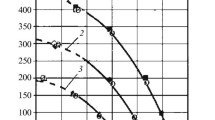Abstract
The importance of studying the hydrodynamics of the glass-melting tank is substantiated. The main equations of a numerical model of the tank hydrodynamics are given. The calculation results of temperature fields and streamlines are given for a glass-melting furnace with an output of 300 tons per day. The adequacy of the calculation results as applied to real furnace operating conditions is demonstrated. The developed model of hydrodynamics of the melting tank can be used in solving applied problems of designing glass-melting furnaces.
Similar content being viewed by others
REFERENCES
V. Ya. Dzyuzer, “Contemporary development of glass-melting furnaces for container glass production,” in: Proc. Intern. Congress “Furnace and Pipe Construction: Heat Regimes, Designs, Automation, and Ecology” [in Russian], Teplotekhnika, Moscow (2004), pp. 48–55.
V. Ya. Dzyuzer, V. S. Shvydkii, and V. B. Kut’in, “Mathematical support for the CAD subsystem of a glass-melting furnace,” Steklo Keram., No. 7, 3–8 (2004).
V. Ya. Dzyuzer, V. S. Shvydkii, and V. B. Kut’in, “Mathematical model of a glass-melting furnace with horseshoe-shaped flame,” Steklo Keram., No. 10, 8–12 (2004).
G. A. Ostroumov, Free Convection in Interior Problem Conditions [in Russian], Gostekhizdat, Moscow-Leningrad (1952).
L. D. Landau and E. M. Lifshits, Mechanics of Continuous Media [in Russian], Gostekhizdat, Moscow (1954).
G. Z. Gershuni and E. M. Zhukhovitskii, Convective Stability of Incompressible Fluids [in Russian], Nauka, Moscow (1972).
A. V. Lykov and B. M. Berkovskii, Convection and Heat Waves [in Russian], Energiya, Moscow (1974).
A. D. Gosman, V. M. Pan, A. K. Ranchel, et al., Numerical Methods for Studying Viscous Fluid Flows [Russian translation], Mir, Moscow (1972).
W. A. Woods and H. Daneshyar, “Boundary conditions and initial value lines for unsteady homentropic flow calculations,” Aeronaut. Quart., 21, 145–162 (1970).
S. Patankar, Numerical Methods for Solving Problems of Heat Transfer And Fluid Dynamics [Russian translation], Energoatomizdat, Moscow (1984).
A. A. Samarskii and E. S. Nikolaev, Methods for Solving Grid Equations [in Russian], Nauka, Moscow (1978).
L. Heigeman and D. Young, Applied iteration methods, Moscow (1986).
Author information
Authors and Affiliations
Additional information
__________
Translated from Steklo i Keramika, No. 1, pp. 3 – 8, January, 2005.
Rights and permissions
About this article
Cite this article
Dzyuzer, V.Y., Shvydkii, V.S. Mathematical Model of Hydrodynamics of a Glass-Melting Tank. Glass Ceram 62, 3–8 (2005). https://doi.org/10.1007/s10717-005-0018-0
Issue Date:
DOI: https://doi.org/10.1007/s10717-005-0018-0




